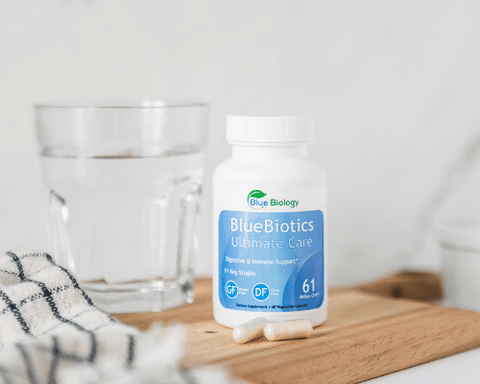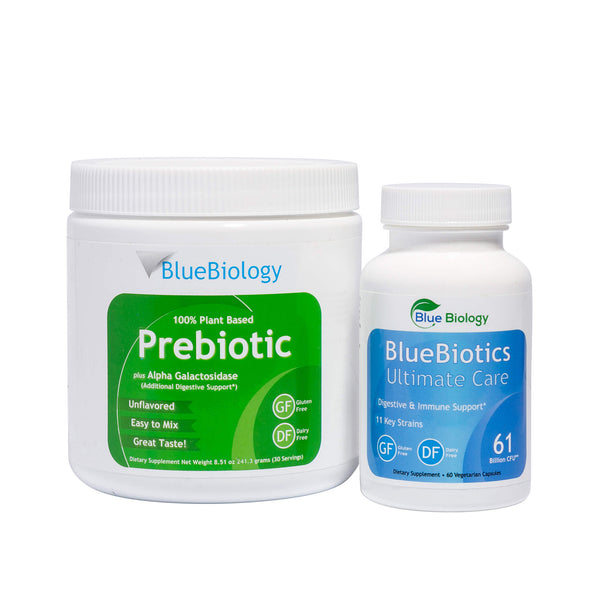Should You Take Probiotics and Prebiotics Together?
Share

If you take probiotics then you have most likely heard about prebiotics. But you may not know how incredibly important they are for one another.
With only a one letter difference between probiotics and prebiotics, you may even be wondering how much of a difference can there be? While they do sound alike and they are related, they are also very different from each other.
Probiotics have received most of the attention over the past several years---and for good reason; there have been countless extensive studies that show how probiotics promote health in many ways.
But in the midst of all of these studies on probiotics a crucial piece of the puzzle has been buried. This is the primary reason why some individuals never see the full benefits of supplementing probiotics. That missing piece is prebiotics.
New to this whole probiotics and prebiotics topic? Right below this is a quick crash-course on each of the two.
Probiotics 101

Probiotics, as you may well already know, are living microorganisms that benefit us, their host. They pass through our stomachs and live throughout the digestive tract.
More specifically, the majority of probiotics are bacteria. There is one probiotic that’s a yeast called saccharomyces boulardii.
The overall collection of all the microorganisms that live throughout the digestive system is called the “microbiome” and there’s a correlation between the health of the microbiome and our overall health. When there’s a good balance in the microbiome, our bodies function efficiently and we’re healthy. When the microbiome is overrun by harmful microorganisms, our organs are less efficient and we leak nutrients.
The microbiome can be negatively affected by numerous factors such as taking antibiotics (which kill probiotics), bad diet, stress, lack of exercise, and more.
Prebiotics are fibers that only healthy, good bacteria can use as food.
Prebiotics not only aid in digestion by helping form stools but they also selectively provide nourishment for good probiotics without fueling the growth of bad bacteria. Prebiotics help probiotics beat bad bacteria in the fight for the defense of your body.
How Probiotics and Prebiotics Work Together
Probiotics are great and have a vast potential to improve your health. However, no probiotic can reach its full potential when it doesn’t have a food source to thrive on, aka a prebiotic.
Prebiotics nourish the beneficial microbes throughout the digestive system which results in a healthier microbiome in general. And as we touched on before, having a healthy microbiome is extremely important because it has a significant influence over our overall health.
The concept of probiotics and prebiotics working together has been recognized to the point where there is a term for it: synbiotics. The concept of synbiotics is that probiotics and prebiotics interact with each other in a symbiotic way that’s beneficial to their host, us.
So What Can You Do to Get More Probiotics and Prebiotics?

Both probiotics and prebiotics are found in the foods we eat. Unfortunately, though, today’s modern diet is sorely lacking in prebiotic fiber. In fact, it’s estimated that only 5% of Americans get the recommended amount of fiber!
On top of that, many of us tend to eat excessive amounts of sugar and salt, which are bad for digestive health, as they feed harmful pathogens rather than the good bacteria in the gut.
That is, of course, saying nothing of the ever-increasing amount of pesticides and antibiotics in the foods we eat every day.
If you suspect you’re one of the many people who don’t eat enough prebiotic fiber, it’s a good idea to proactively work on incorporating more into your diet.
Some foods that are high in prebiotic fiber include:
- Chickpeas
- Lentils
- Chicory
- Grapefruit
- Wheat Bran
- Barley
- Oats
- Asparagus
- Garlic
- Onions
- Shallots
- Jerusalem Artichoke
- Baked Beans
- Soy Beans
- Red Kidney Beans
- Bananas
- Apples
- Almonds
- Pistachios
- Flaxseed
- Leeks
- Watermelon
- Jicama Root
- Seaweed
We should all strive to get more prebiotic fiber from the foods we eat. It’s also good to supplement with a prebiotic fiber supplement like BlueBiology Prebiotic.
Our supplement contains the three types of prebiotics: inulin, fructooligosaccharides, and galacto-oligosaccharides. This ensures that you get a wide spectrum of prebiotics, which is ideal because each type of probiotic has certain prebiotics that they prefer to feed on.
You can also get probiotics from food. Some of the more notable foods that contain probiotics include:
- Yogurt
- Sauerkraut
- Cheese (aged cheeses such as mozzarella, cheddar, and gouda)
- Pickles
- Kimchi
- Kombucha
- Kefir
- Miso
- Buttermilk
- Olives
- Tempeh
It’s great to get probiotics both through your diet and from supplements. Our supplement, BlueBiotics Ultimate Care contains 11 strains of probiotics, each having their own unique probiotic benefits. The more diverse the probiotic strains you take in, the more health benefits you’ll get.
So Should You Take Probiotics and Prebiotics Together?
Yes! Especially if you don’t get enough prebiotic fibers through your regular diet, which unfortunately is the case for most people. There are so many aspects of today’s diet and lifestyle factors that make it difficult to get enough probiotics and prebiotics. That’s where supplements can help.
Learn More About BlueBiology Prebiotic Powder
Learn More About BlueBiotics: Ultimate Care Probiotic

